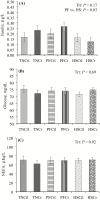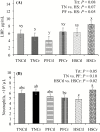Effects of dietary chromium propionate on growth performance, metabolism, and immune biomarkers in heat-stressed finishing pigs1
- PMID: 30590717
- PMCID: PMC6396268
- DOI: 10.1093/jas/sky484
Effects of dietary chromium propionate on growth performance, metabolism, and immune biomarkers in heat-stressed finishing pigs1
Abstract
Study objectives were to determine the effects of chromium (Cr) propionate (Cr propionate 0.04%; 0.5 g/kg of feed to deliver 200 parts per billion Cr/d; KemTRACE Cr, Kemin Industries, Inc., Des Moines, IA) on growth performance, metabolism, and health biomarkers in heat-stressed and nutrient-restricted pigs. Crossbred barrows (n = 96; 105 ± 1 kg BW) were enlisted in an experiment conducted in two replicates, blocked by initial BW, and randomly assigned to one of six dietary-environmental treatments: (i) thermoneutral (TN) and fed ad libitum a control diet (TNCtl), (ii) TN and fed ad libitum a Cr supplemented diet (TNCr), (iii) TN and pair-fed a control diet (PFCtl), (iv) TN and pair-fed a Cr supplemented diet (PFCr), (v) heat stress (HS) and ad libitum fed a control diet (HSCtl), or (vi) HS and ad libitum fed a Cr supplemented diet (HSCr). The study consisted of three experimental periods (P). During P0 (5 d), all pigs were housed in TN conditions (21.3 ± 0.1 °C, 56.8 ± 0.3% relative humidity [RH]) and fed the control diet ad libitum. During P1 (5 d), pigs were fed their respective dietary treatments ad libitum and kept in TN conditions. During P2 (35 d), HSCtl and HSCr-treated pigs were fed ad libitum and exposed to progressive cyclical HS conditions (27 to 31 °C, 50 ± 0.3% RH), while TNCtl, TNCr, PFCtl, and PFCr pigs remained in TN conditions and were fed ad libitum or pair-fed to their respective HSCtl and HSCr counterparts to eliminate the confounding effects of dissimilar feed intake. Overall, HS pigs had increased (P < 0.01) rectal temperature, skin temperature, and respiration rate (0.3 °C, 3.8 °C, and 32 breaths per minute, respectively) relative to TN pigs. Overall, HS decreased ADFI and ADG (20 and 21%, respectively; P < 0.01) compared with TN controls. Final BW tended to be increased in HSCr (2.7 kg, P = 0.06) compared with HSCtl pigs. Similarly, ADG tended to be increased during P2 in HSCr relative to HSCtl-treatment (0.77 vs. 0.72 kg/d; P = 0.10). There were no effects of Cr on most production parameters, but ADFI tended to be increased in Cr relative to Ctl-fed pigs (3.19 vs. 3.09 kg/d; P = 0.08). No effects of Cr supplementation were detected on circulating glucose, insulin, NEFA, cholesterol, triglycerides, or lipopolysaccharide binding protein. However, blood neutrophils were increased in HSCr (37%; P < 0.01) relative to HSCtl pigs. In summary, these results suggest Cr supplementation may benefit growth performance during HS.
Keywords: chromium; growth performance; heat stress; pig.
© The Author(s) 2018. Published by Oxford University Press on behalf of the American Society of Animal Science. All rights reserved. For permissions, please e-mail: journals.permissions@oup.com.
Figures





Similar articles
-
Effects of zinc amino acid complex on biomarkers of gut integrity and metabolism during and following heat stress or feed restriction in pigs.J Anim Sci. 2018 Sep 29;96(10):4173-4185. doi: 10.1093/jas/sky293. J Anim Sci. 2018. PMID: 30256966 Free PMC article.
-
Effects of heat stress and insulin sensitizers on pig adipose tissue.J Anim Sci. 2018 Mar 6;96(2):510-520. doi: 10.1093/jas/skx067. J Anim Sci. 2018. PMID: 29385474 Free PMC article.
-
Effects of dietary live yeast supplementation on growth performance and biomarkers of metabolism and inflammation in heat-stressed and nutrient-restricted pigs.Transl Anim Sci. 2021 May 27;5(2):txab072. doi: 10.1093/tas/txab072. eCollection 2021 Apr. Transl Anim Sci. 2021. PMID: 34189415 Free PMC article.
-
Potential use of chromium to combat thermal stress in animals: A review.Sci Total Environ. 2020 Mar 10;707:135996. doi: 10.1016/j.scitotenv.2019.135996. Epub 2019 Dec 9. Sci Total Environ. 2020. PMID: 31865090 Review.
-
The Genetics of Thermoregulation in Pigs: A Review.Front Vet Sci. 2021 Dec 13;8:770480. doi: 10.3389/fvets.2021.770480. eCollection 2021. Front Vet Sci. 2021. PMID: 34966808 Free PMC article. Review.
Cited by
-
Reproductive and lactational responses of multiparous dairy cattle to short-term postpartum chromium supplementation during the summer months.JDS Commun. 2022 Dec 22;4(2):161-165. doi: 10.3168/jdsc.2022-0287. eCollection 2023 Mar. JDS Commun. 2022. PMID: 36974212 Free PMC article.
-
Meta-Analysis of the Effects of Organic Chromium Supplementation on the Growth Performance and Carcass Quality of Weaned and Growing-Finishing Pigs.Animals (Basel). 2023 Jun 16;13(12):2014. doi: 10.3390/ani13122014. Animals (Basel). 2023. PMID: 37370524 Free PMC article.
-
Research progress on anti-stress nutrition strategies in swine.Anim Nutr. 2023 Apr 6;13:342-360. doi: 10.1016/j.aninu.2023.03.006. eCollection 2023 Jun. Anim Nutr. 2023. PMID: 37214213 Free PMC article. Review.
-
Chromium Methionine and Ractopamine Supplementation in Summer Diets for Grower-Finisher Pigs Reared under Heat Stress.Animals (Basel). 2023 Aug 19;13(16):2671. doi: 10.3390/ani13162671. Animals (Basel). 2023. PMID: 37627462 Free PMC article.
-
Effects of dietary chromium propionate and space allowance on performance and carcass responses of growing-finishing pigs.Transl Anim Sci. 2021 Jun 27;5(3):txab112. doi: 10.1093/tas/txab112. eCollection 2021 Jul. Transl Anim Sci. 2021. PMID: 34316540 Free PMC article.
References
-
- Beede D. K., and Collier R. J.. 1986. Potential nutritional strategies for intensively managed cattle during thermal stress. J. Anim. Sci. 62:543–554. doi:10.2527/jas1986.622543x - DOI
-
- Boddicker R. L., Seibert J. T., Johnson J. S., Pearce S. C., Selsby J. T., Gabler N. K., Lucy M. C., Safranski T. J., Rhoads R. P., Baumgard L. H., et al. . 2014. Gestational heat stress alters postnatal offspring body composition indices and metabolic parameters in pigs. PLoS One 9:e110859. doi:10.1371/journal.pone.0110859 - DOI - PMC - PubMed
-
- Burton J. L., Mallard B. A., and Mowat D. N.. 1993. Effects of supplemental chromium on immune responses of periparturient and early lactation dairy cows. J. Anim. Sci. 71:1532–1539. doi:10.2527/1993.7161532x - PubMed
MeSH terms
Substances
LinkOut - more resources
Full Text Sources
Medical

